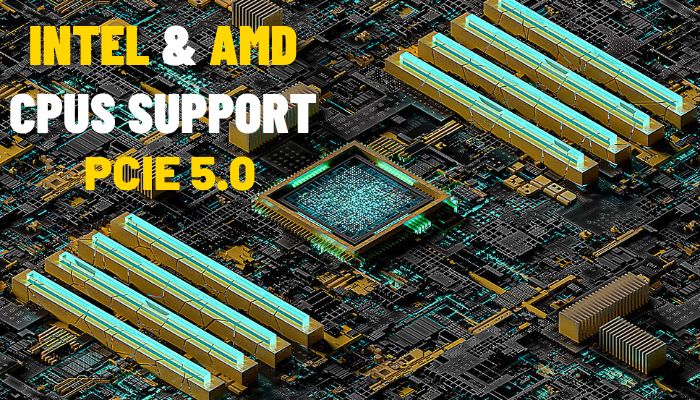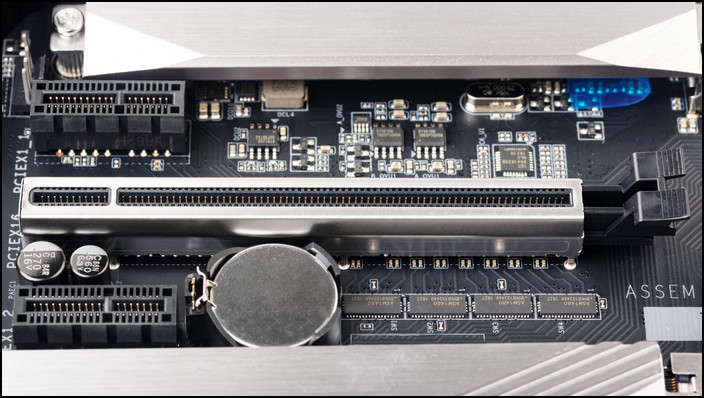Get, Set, Go!
What if your computer could run lighting fast like Sonic? Well, I’m not kidding when I say PCIe 5.0 makes you feel just like that over the last-gen peripheral interconnect technology, A.K.A. PCIe.
As it’s already made its way to the mainstream PC market, you should know if you could leverage the blessing of what it offers. Hence, comes CPU compatibility.
So, how do the two major players, Intel and AMD, shape up with this technology? Let’s find the answer.
What are PCIe & PCIe 5.0?
The abbreviate form of Peripherals Component Interconnect Express is PCIe. This technology allows you to connect high-speed components to the system, that directly communicate with the CPU. Superfast NVMe drives, GPU, WiFi, RAID, audio cards, etc., all utilize the PCIe interface.
Such textbook words might get your head spinning a wee bit; let me clear the air.
Think how amazing it would be if you could link an additional hand to your body. You could eventually do more than usual. But it had to be controlled by your brain, just like your original pair of hands. Ergo, a spontaneous motion is created without any interference halfway.
With reference to that, to enhance your systems’ capability of carrying out diverse operations such as graphics processing, enhanced wireless connectivity, etc., the PCIe interface ties individual components with the brain— the CPU. You know, the PCIe interface has slots such as x1, x4, x8, x16, etc., to connect different peripherals. These slots offer PCIe lane access for the component. The number assigned to each slot type suggests that the installed component can take advantage of that amount of lanes to transfer data.
You know, the PCIe interface has slots such as x1, x4, x8, x16, etc., to connect different peripherals. These slots offer PCIe lane access for the component. The number assigned to each slot type suggests that the installed component can take advantage of that amount of lanes to transfer data.
Though, PCIe and CPU cables are different, they have similarities in appearance and looks same in bare eyes.
Speaking of PCIe, generation 5 is the latest and greatest iteration of this technology. PCIe 5.0 offers a bandwidth and data transfer rate of 128 GB/s and 32 GT/s. Which translates to twice as fast compared to PCIe 4.0.
Intel & AMD Processor PCIe 5.0 Compatibility
Processor compatibility is crucial when it comes to the PCIe interface. Even though a newer iteration is out, it’s pointless if the CPU is incompatible.
Both Intel and AMD have entered into the realm of PCIe 5.0 to start a new era of blazing-fast computing experience.
So does that mean your current processor manufactured by them is able to harness the benefit of PCIe 5.0? Not quite!
See, there are specific CPUs from Intel and AMD that can capitalize gen 5 PCIe. Ryzen 7000 from AMD and 12th and 12th gen core processors from Intel have native support for PCIe 5.0.
Here’s a quick look at PCIe 5.0 supported CPUs from Intel and AMD:
| CPU Family (Intel and AMD) | PCIe 5.0 Supported CPU | Maximum PCIe Lanes |
|---|---|---|
| Intel Core i9 | 12900/F/T, 12900K/KS/KF, 13900/F/T, 13900K/KS/KF | 20 |
| Intel Core i7 | 12700/F/T, 12700K/KF, 13700/F/T, 13700K/KF | 20 |
| Intel Core i5 | 12600/T, 12600K/KF, 12500/T, 12400/F/T, 13600/T, 13600 K/KF, 13500/T, 13400/F/T, | 20 |
| Intel Core i3 | 13100/F, 12300/T, 12100/F/T | 20 |
| Intel Pentium & Celeron | Pentium Gold G7400/T, Celeron G6900/T | 20 |
| Intel Mobile | 13th gen (HX, H, P, U) and 12th gen (HX) processors e.g., i9 13980HX, 12950HX, i9 13900H, i7 1370p, i7 1365U, etc. | N/A |
| AMD Ryzen 9 | 7950X, 7950X3D, 7900X, 7900X3D, | 24 |
| AMD Ryzen 7 | 7800X, 7800X3D, 7700X, 7700 | 24 |
| AMD Ryzen 5 | 7600X, 7600 | 24 |
| AMD Ryzen Mobile | R9 7945HX, R9 7845HX, R7 7745HX, R5 7645HX, | N/A |
That’s a lot of processor SKUs, to be honest with you. You have a wide range of CPUs in front of you to choose from.
So that’s it? Not really. You need a compatible motherboard and CPU to leverage the benefit of PCIe 5.0.
A Glimpse on PCIe 5.0 Compatible Motherboards
You know there’s a wide range of chipsets and motherboards currently available in the market. Choose them as per your CPU model and pair them up to exploit PCIe 5.0.
Here are all the PCIe 5.0 compatible Intel chipsets:
| Intel Chipset | PCIe 5.0 Slot Configuration | Release Date | Target Audience |
|---|---|---|---|
| Z790 | 1x16 or 2x8 lanes | Q4 2022 | Enthusiasts, high-end gamers, and creators. |
| H770 | 1x16 or 2x8 lanes | Q1 2023 | Mainstream gamers and general users. |
| B760 | 1x16 lanes | Q1 2023 | Mainstream gamers and streamers on a budget. |
| Z690 | 1x16 or 2x8 lanes | Q4 2021 | Enthusiasts, high-end gamers, and creators. |
| H670 | 1x16 or 2x8 lanes | Q1 2022 | Mainstream gamers and general users. |
| B660 | 1x16 lanes | Q1 2022 | Mainstream gamers and streamers on a budget. |
| H610 | 1x16 lanes | Q1 2022 | Regular users with basic operations in mind. |
| W680 | 1x16 or 2x8 lanes | Q1 2022 | Engineers, Professional creators, and heavy workstations. |
| Q670 | 1x16 or 2x8 lanes | Q1 2022 | Budget workstations and business. |
Here are all the PCIe 5.0 AMD Motherboard chipsets:
| AMD Chipsets | PCIe 5.0 Slot Configuration | Release Date | Usable PCIe 5.0 lanes | Target Audience |
|---|---|---|---|---|
| X670E | 1x16 or 2x8 lanes (GPU) + 1x4 (NVMe) + 4 (Chipset) | Q4 2022 | 24 | Enthusiasts and high-end gamers. |
| X670 | 1x4 lanes for NVMe + 4 (Chipset) | Q4 2022 | 8 | High-end users who don’t need all those expansion slots. |
| B650E | 1x16 or 2x8 lanes (GPU) + 1x4 (NVMe) + 4 (Chipset) | Q4 2022 | 24 | High-end consumers. |
| B650 | 1x4 lanes for NVMe (optional) | Q4 2022 | 0 | Low to mid-budget buyers. |
Also, keep in mind that the PCIe 5.0 compatible motherboards are quite expensive, and cost you some extra money.
Is PCIe 5.0 Worth It?
PCIe 5.0 is a significant leap forward in rapidly developing technology in computers. It offers an astronomical jump in speed over its predecessor. The availability and price, however, are expected to be steep at the early stage.
But does it make any difference for the mass?
You know as of today, the most popular drives widely used are PCIe 3.0. For regular consumers, it offers more than enough speed. But for people who play around with big data day and night, high-speed operation will be a game changer.
And guess what? PCIe 4.0 is now serving well on that front. On top of that, PCIe 5.0 drives and graphics cards are non-existent. Even the mighty RTX 4090 utilizes PCIe 4.0 x16 lanes.
Does that make PCIe 5.0 DOA? Not a chance!
See, PCIe 5.0 is definitely going to make a difference in big data centers and cloud service operations. It is twice as fast as the last-gen PCIe 4.0. As a result, it will save time reading and writing huge chunks of data, which generates a substantial advantage.
Companies like Google, Amazon, Microsoft, and others will surely pull the trigger on PCIe 5.0 once there is an option. It is undoubtedly worth it, if you think about it, wearing their glasses.
So, the answer to whether PCIe 5.0 is worth it or not is both Yes and No. If you have the money, and you need that level of data transfer speed, just go for it. But for gaming, regular usage, and light creative works you’ll be totally fine without it.
However, if you want to save money and a little bit of performance, you can check the compatible AMD and Intel CPU with PCIe 4.0.
FAQs
Do Intel 12th-gen processors have support for PCIe 5.0?
Yes, Intel 12th gen core CPUs natively support PCIe gen 5.0. They are the first chipmakers to introduce PCIe 5.0 to the mainstream market.
When did PCIe 5.0 come out?
With the release of Alder Lake A.K.A. 12th gen Intel processors back on November 4, 2021, PCIe 5.0 came out to the market. But it was announced in 2019. Although, there are no drives currently available to exploit this technology. They are supposed to hit the market in 2023.
Does AMD support PCIe 5?
Yes, AMD fully supports PCIe 5.0 on their Ryzen 7000 processors and 600 series chipsets such as X670E, B650E, etc.
Ending Remarks
There’s growing hype around PCIe 5.0 and how CPU manufacturers present it. Hence, comes this article provides a complete list of supported processors. Hope you find it useful.
For more queries, comment down below.
